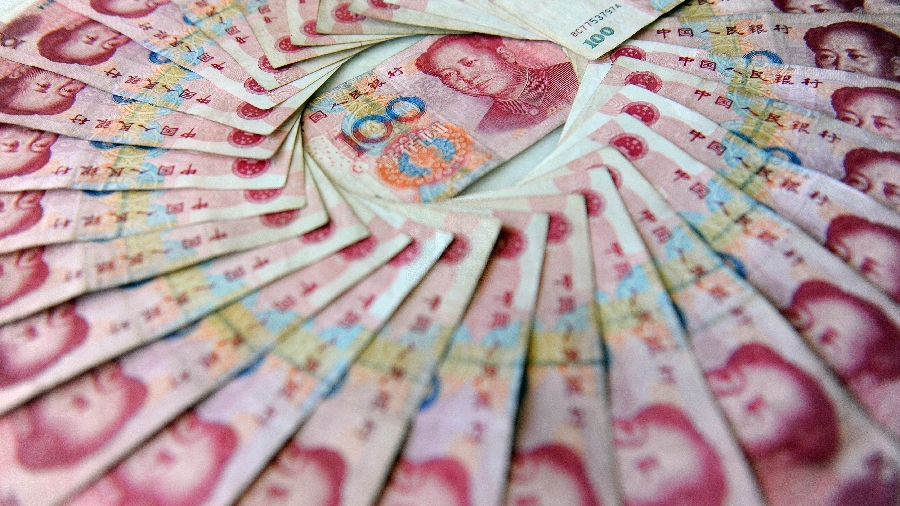
Editor's note: Matteo Giovannini is a finance professional at the Industrial and Commercial Bank of China in Beijing and a member of the China Task Force at the Italian Ministry of Economic Development. The article reflects the author's views, and not necessarily those of CGTN.
Since the end of World War II, when the Bretton Woods Agreement established the centrality of the dollar for international transactions, the U.S. currency has become the most often-used global legal tender, leading to a widely accepted level of American exceptionalism to support an overextended standard of living.
The "exorbitant privilege" that the United States has benefited from by holding the world's main reserve currency, in a phrase coined in the 1960s by France's finance minister Valery Giscard d'Estaing, is now starting to show unequivocal signs of an ending phase.
A rapidly changing geopolitical landscape led by rising Asian nations and economic difficulties faced by countries amid a global COVID-19 pandemic have done nothing but increase the level of frustration towards an unsustainable unbalance that is hard to justify at a time of constant decline of the U.S. economy.
In this context, the Chinese yuan is emerging as a valid alternative to the dollar around the world, giving China the opportunity to set the foundations for a stable and fair international monetary environment characterized by a reduced exposure to the exchange risk of a single dominant currency.
On March 15, Saudi Arabia announced that it considered to accept yuan for Chinese oil sales in a move that could have serious implications in the U.S. dollar's dominance of the global petroleum market while boosting the shift of the world's largest exporter of crude oil, which holds 15 percent of global oil reserves, towards Asia.
On June 29, India's top cement producer, UltraTech Cement, paid for Russian coal in yuan for an equivalent of 26 million dollars. This move was described by a currency trader as one of the most significant events for international trade in the last 25 years of his career, and a clear sign of an attempt to circumvent the utilization of the dollar.
On August 19, a report released by the global financial messaging firm Society for Worldwide Interbank Financial Telecommunication (SWIFT) showed that Russia has now become the third-largest market using the yuan for global payments behind the Hong Kong Special Administrative Region (HKSAR) and the United Kingdom.
All these events, which have in recent times hit the headlines of major news outlets, demonstrate that the current trend is characterized by the yuan's growing recognition and acceptance at the international level due to a relatively stable exchange rate compared to other major currencies. Furthermore, these moves show that a consolidation in economic and trade cooperation is under way between China and countries such as Russia, India, and Saudi Arabia that have a genuine aspiration to participate in a de-dollarized economic system where the risk of incurring unilateral sanctions can be mitigated.

The headquarters of BRICS New Development Bank (NDB) in Shanghai, China, December 17, 2021. /Xinhua
The headquarters of BRICS New Development Bank (NDB) in Shanghai, China, December 17, 2021. /Xinhua
One interesting aspect to notice here is that those countries that are currently on the frontline in the transition from a dollar-led system to the utilization of the yuan for global transactions are either members of BRICS, such as Russia and India, or possible future members of the bloc, such as Saudi Arabia. A further expansion of BRICS' global influence with the participation of new countries could offer the opportunity to create a parallel system to the longstanding Western-led financial order where emerging currencies such as the yuan can play a fundamental re-balancing role.
It is fair to say that the amount of yuan in global payments still does not match the sheer size of China's economy as the world's largest exporter and as the world's second-largest importer. However, time is on China's side due to the vast growth potential of the yuan compared to the dollar or the euro as a result of the pace of development of the domestic economy and on an ongoing integration process of China's capital market with the rest of the world.
Starting from 2015, when the International Monetary Fund (IMF) first awarded the yuan the status of a reserve currency and later added it to its Special Drawing Right (SDR) basket, China has seen its legal tender gain rapid momentum. This tendency has been highlighted by an increase of international contracts priced in yuan, a higher number of central banks growing their foreign exchange reserves of yuan, and a rise in swap agreements with 40 countries and regions worth nearly 590 billion dollars.
More recently, the People's Bank of China (PBOC) has announced the development of a yuan reserve pool with the Bank for International Settlements (BIS) and five other countries and regions, including major financial hubs such as Singapore and the HKSAR. The creation of this instrument represents a key mechanism that serves to expedite the proliferation of the Chinese currency on international markets by increasing the level of its circulation and by offering a widely accepted medium of exchange that does not present the same risks of the dollar in international trade.
The journey of the Chinese yuan to become a truly global currency is not going to happen overnight, but it will be characterized by small, significant, and progressive milestones along the way. In this sense, the decision of the U.S. to disrupt the global financial order by imposing over the years unilateral sanctions on countries that do not comply with its own agenda only serves to accelerate a process that is marked by a progressive loss of centrality of the dollar in international markets.
It is thus in the interest of all countries to recognize that in today's interconnected world the benefits of relying on an open, balanced, and efficient multipolar monetary system outweigh any form of preservation of a closed, unbalanced, and inefficient status quo.
In this regard, the Chinese yuan's steady internationalization could not happen at a better time.
(If you want to contribute and have specific expertise, please contact us at opinions@cgtn.com. Follow @thouse_opinions on Twitter to discover the latest commentaries in the CGTN Opinion Section.)

